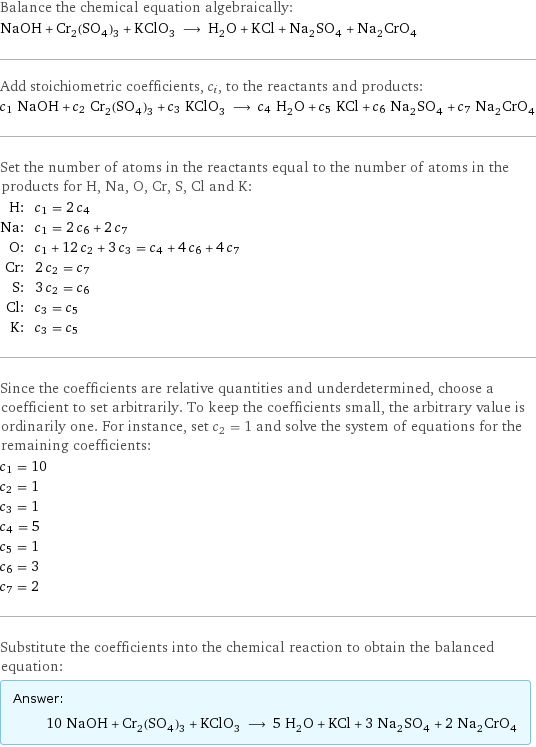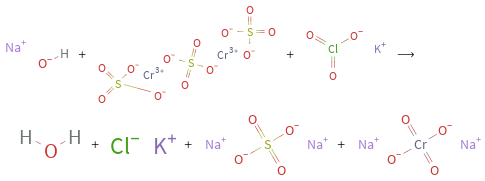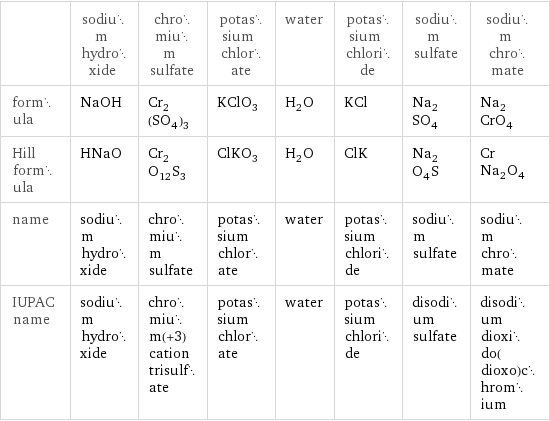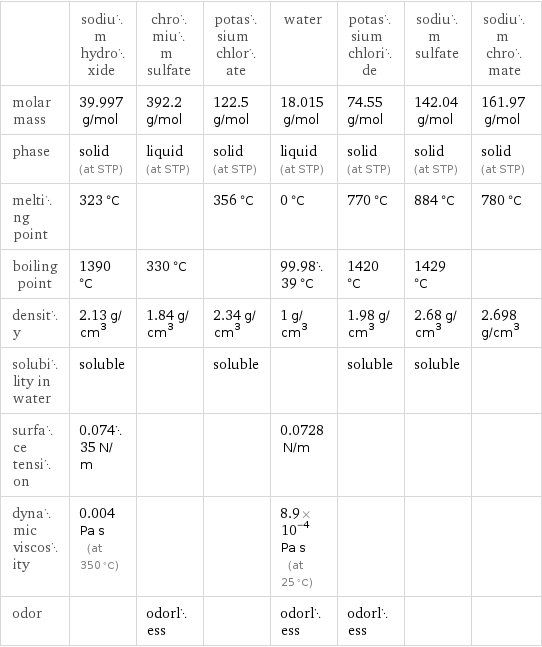Input interpretation

NaOH sodium hydroxide + Cr_2(SO_4)_3 chromium sulfate + KClO_3 potassium chlorate ⟶ H_2O water + KCl potassium chloride + Na_2SO_4 sodium sulfate + Na_2CrO_4 sodium chromate
Balanced equation

Balance the chemical equation algebraically: NaOH + Cr_2(SO_4)_3 + KClO_3 ⟶ H_2O + KCl + Na_2SO_4 + Na_2CrO_4 Add stoichiometric coefficients, c_i, to the reactants and products: c_1 NaOH + c_2 Cr_2(SO_4)_3 + c_3 KClO_3 ⟶ c_4 H_2O + c_5 KCl + c_6 Na_2SO_4 + c_7 Na_2CrO_4 Set the number of atoms in the reactants equal to the number of atoms in the products for H, Na, O, Cr, S, Cl and K: H: | c_1 = 2 c_4 Na: | c_1 = 2 c_6 + 2 c_7 O: | c_1 + 12 c_2 + 3 c_3 = c_4 + 4 c_6 + 4 c_7 Cr: | 2 c_2 = c_7 S: | 3 c_2 = c_6 Cl: | c_3 = c_5 K: | c_3 = c_5 Since the coefficients are relative quantities and underdetermined, choose a coefficient to set arbitrarily. To keep the coefficients small, the arbitrary value is ordinarily one. For instance, set c_2 = 1 and solve the system of equations for the remaining coefficients: c_1 = 10 c_2 = 1 c_3 = 1 c_4 = 5 c_5 = 1 c_6 = 3 c_7 = 2 Substitute the coefficients into the chemical reaction to obtain the balanced equation: Answer: | | 10 NaOH + Cr_2(SO_4)_3 + KClO_3 ⟶ 5 H_2O + KCl + 3 Na_2SO_4 + 2 Na_2CrO_4
Structures

+ + ⟶ + + +
Names

sodium hydroxide + chromium sulfate + potassium chlorate ⟶ water + potassium chloride + sodium sulfate + sodium chromate
Equilibrium constant
![Construct the equilibrium constant, K, expression for: NaOH + Cr_2(SO_4)_3 + KClO_3 ⟶ H_2O + KCl + Na_2SO_4 + Na_2CrO_4 Plan: • Balance the chemical equation. • Determine the stoichiometric numbers. • Assemble the activity expression for each chemical species. • Use the activity expressions to build the equilibrium constant expression. Write the balanced chemical equation: 10 NaOH + Cr_2(SO_4)_3 + KClO_3 ⟶ 5 H_2O + KCl + 3 Na_2SO_4 + 2 Na_2CrO_4 Assign stoichiometric numbers, ν_i, using the stoichiometric coefficients, c_i, from the balanced chemical equation in the following manner: ν_i = -c_i for reactants and ν_i = c_i for products: chemical species | c_i | ν_i NaOH | 10 | -10 Cr_2(SO_4)_3 | 1 | -1 KClO_3 | 1 | -1 H_2O | 5 | 5 KCl | 1 | 1 Na_2SO_4 | 3 | 3 Na_2CrO_4 | 2 | 2 Assemble the activity expressions accounting for the state of matter and ν_i: chemical species | c_i | ν_i | activity expression NaOH | 10 | -10 | ([NaOH])^(-10) Cr_2(SO_4)_3 | 1 | -1 | ([Cr2(SO4)3])^(-1) KClO_3 | 1 | -1 | ([KClO3])^(-1) H_2O | 5 | 5 | ([H2O])^5 KCl | 1 | 1 | [KCl] Na_2SO_4 | 3 | 3 | ([Na2SO4])^3 Na_2CrO_4 | 2 | 2 | ([Na2CrO4])^2 The equilibrium constant symbol in the concentration basis is: K_c Mulitply the activity expressions to arrive at the K_c expression: Answer: | | K_c = ([NaOH])^(-10) ([Cr2(SO4)3])^(-1) ([KClO3])^(-1) ([H2O])^5 [KCl] ([Na2SO4])^3 ([Na2CrO4])^2 = (([H2O])^5 [KCl] ([Na2SO4])^3 ([Na2CrO4])^2)/(([NaOH])^10 [Cr2(SO4)3] [KClO3])](../image_source/d91b886c87958ea76595168476033354.png)
Construct the equilibrium constant, K, expression for: NaOH + Cr_2(SO_4)_3 + KClO_3 ⟶ H_2O + KCl + Na_2SO_4 + Na_2CrO_4 Plan: • Balance the chemical equation. • Determine the stoichiometric numbers. • Assemble the activity expression for each chemical species. • Use the activity expressions to build the equilibrium constant expression. Write the balanced chemical equation: 10 NaOH + Cr_2(SO_4)_3 + KClO_3 ⟶ 5 H_2O + KCl + 3 Na_2SO_4 + 2 Na_2CrO_4 Assign stoichiometric numbers, ν_i, using the stoichiometric coefficients, c_i, from the balanced chemical equation in the following manner: ν_i = -c_i for reactants and ν_i = c_i for products: chemical species | c_i | ν_i NaOH | 10 | -10 Cr_2(SO_4)_3 | 1 | -1 KClO_3 | 1 | -1 H_2O | 5 | 5 KCl | 1 | 1 Na_2SO_4 | 3 | 3 Na_2CrO_4 | 2 | 2 Assemble the activity expressions accounting for the state of matter and ν_i: chemical species | c_i | ν_i | activity expression NaOH | 10 | -10 | ([NaOH])^(-10) Cr_2(SO_4)_3 | 1 | -1 | ([Cr2(SO4)3])^(-1) KClO_3 | 1 | -1 | ([KClO3])^(-1) H_2O | 5 | 5 | ([H2O])^5 KCl | 1 | 1 | [KCl] Na_2SO_4 | 3 | 3 | ([Na2SO4])^3 Na_2CrO_4 | 2 | 2 | ([Na2CrO4])^2 The equilibrium constant symbol in the concentration basis is: K_c Mulitply the activity expressions to arrive at the K_c expression: Answer: | | K_c = ([NaOH])^(-10) ([Cr2(SO4)3])^(-1) ([KClO3])^(-1) ([H2O])^5 [KCl] ([Na2SO4])^3 ([Na2CrO4])^2 = (([H2O])^5 [KCl] ([Na2SO4])^3 ([Na2CrO4])^2)/(([NaOH])^10 [Cr2(SO4)3] [KClO3])
Rate of reaction
![Construct the rate of reaction expression for: NaOH + Cr_2(SO_4)_3 + KClO_3 ⟶ H_2O + KCl + Na_2SO_4 + Na_2CrO_4 Plan: • Balance the chemical equation. • Determine the stoichiometric numbers. • Assemble the rate term for each chemical species. • Write the rate of reaction expression. Write the balanced chemical equation: 10 NaOH + Cr_2(SO_4)_3 + KClO_3 ⟶ 5 H_2O + KCl + 3 Na_2SO_4 + 2 Na_2CrO_4 Assign stoichiometric numbers, ν_i, using the stoichiometric coefficients, c_i, from the balanced chemical equation in the following manner: ν_i = -c_i for reactants and ν_i = c_i for products: chemical species | c_i | ν_i NaOH | 10 | -10 Cr_2(SO_4)_3 | 1 | -1 KClO_3 | 1 | -1 H_2O | 5 | 5 KCl | 1 | 1 Na_2SO_4 | 3 | 3 Na_2CrO_4 | 2 | 2 The rate term for each chemical species, B_i, is 1/ν_i(Δ[B_i])/(Δt) where [B_i] is the amount concentration and t is time: chemical species | c_i | ν_i | rate term NaOH | 10 | -10 | -1/10 (Δ[NaOH])/(Δt) Cr_2(SO_4)_3 | 1 | -1 | -(Δ[Cr2(SO4)3])/(Δt) KClO_3 | 1 | -1 | -(Δ[KClO3])/(Δt) H_2O | 5 | 5 | 1/5 (Δ[H2O])/(Δt) KCl | 1 | 1 | (Δ[KCl])/(Δt) Na_2SO_4 | 3 | 3 | 1/3 (Δ[Na2SO4])/(Δt) Na_2CrO_4 | 2 | 2 | 1/2 (Δ[Na2CrO4])/(Δt) (for infinitesimal rate of change, replace Δ with d) Set the rate terms equal to each other to arrive at the rate expression: Answer: | | rate = -1/10 (Δ[NaOH])/(Δt) = -(Δ[Cr2(SO4)3])/(Δt) = -(Δ[KClO3])/(Δt) = 1/5 (Δ[H2O])/(Δt) = (Δ[KCl])/(Δt) = 1/3 (Δ[Na2SO4])/(Δt) = 1/2 (Δ[Na2CrO4])/(Δt) (assuming constant volume and no accumulation of intermediates or side products)](../image_source/ce30d396b9f9c203969bed31370b877e.png)
Construct the rate of reaction expression for: NaOH + Cr_2(SO_4)_3 + KClO_3 ⟶ H_2O + KCl + Na_2SO_4 + Na_2CrO_4 Plan: • Balance the chemical equation. • Determine the stoichiometric numbers. • Assemble the rate term for each chemical species. • Write the rate of reaction expression. Write the balanced chemical equation: 10 NaOH + Cr_2(SO_4)_3 + KClO_3 ⟶ 5 H_2O + KCl + 3 Na_2SO_4 + 2 Na_2CrO_4 Assign stoichiometric numbers, ν_i, using the stoichiometric coefficients, c_i, from the balanced chemical equation in the following manner: ν_i = -c_i for reactants and ν_i = c_i for products: chemical species | c_i | ν_i NaOH | 10 | -10 Cr_2(SO_4)_3 | 1 | -1 KClO_3 | 1 | -1 H_2O | 5 | 5 KCl | 1 | 1 Na_2SO_4 | 3 | 3 Na_2CrO_4 | 2 | 2 The rate term for each chemical species, B_i, is 1/ν_i(Δ[B_i])/(Δt) where [B_i] is the amount concentration and t is time: chemical species | c_i | ν_i | rate term NaOH | 10 | -10 | -1/10 (Δ[NaOH])/(Δt) Cr_2(SO_4)_3 | 1 | -1 | -(Δ[Cr2(SO4)3])/(Δt) KClO_3 | 1 | -1 | -(Δ[KClO3])/(Δt) H_2O | 5 | 5 | 1/5 (Δ[H2O])/(Δt) KCl | 1 | 1 | (Δ[KCl])/(Δt) Na_2SO_4 | 3 | 3 | 1/3 (Δ[Na2SO4])/(Δt) Na_2CrO_4 | 2 | 2 | 1/2 (Δ[Na2CrO4])/(Δt) (for infinitesimal rate of change, replace Δ with d) Set the rate terms equal to each other to arrive at the rate expression: Answer: | | rate = -1/10 (Δ[NaOH])/(Δt) = -(Δ[Cr2(SO4)3])/(Δt) = -(Δ[KClO3])/(Δt) = 1/5 (Δ[H2O])/(Δt) = (Δ[KCl])/(Δt) = 1/3 (Δ[Na2SO4])/(Δt) = 1/2 (Δ[Na2CrO4])/(Δt) (assuming constant volume and no accumulation of intermediates or side products)
Chemical names and formulas

| sodium hydroxide | chromium sulfate | potassium chlorate | water | potassium chloride | sodium sulfate | sodium chromate formula | NaOH | Cr_2(SO_4)_3 | KClO_3 | H_2O | KCl | Na_2SO_4 | Na_2CrO_4 Hill formula | HNaO | Cr_2O_12S_3 | ClKO_3 | H_2O | ClK | Na_2O_4S | CrNa_2O_4 name | sodium hydroxide | chromium sulfate | potassium chlorate | water | potassium chloride | sodium sulfate | sodium chromate IUPAC name | sodium hydroxide | chromium(+3) cation trisulfate | potassium chlorate | water | potassium chloride | disodium sulfate | disodium dioxido(dioxo)chromium
Substance properties

| sodium hydroxide | chromium sulfate | potassium chlorate | water | potassium chloride | sodium sulfate | sodium chromate molar mass | 39.997 g/mol | 392.2 g/mol | 122.5 g/mol | 18.015 g/mol | 74.55 g/mol | 142.04 g/mol | 161.97 g/mol phase | solid (at STP) | liquid (at STP) | solid (at STP) | liquid (at STP) | solid (at STP) | solid (at STP) | solid (at STP) melting point | 323 °C | | 356 °C | 0 °C | 770 °C | 884 °C | 780 °C boiling point | 1390 °C | 330 °C | | 99.9839 °C | 1420 °C | 1429 °C | density | 2.13 g/cm^3 | 1.84 g/cm^3 | 2.34 g/cm^3 | 1 g/cm^3 | 1.98 g/cm^3 | 2.68 g/cm^3 | 2.698 g/cm^3 solubility in water | soluble | | soluble | | soluble | soluble | surface tension | 0.07435 N/m | | | 0.0728 N/m | | | dynamic viscosity | 0.004 Pa s (at 350 °C) | | | 8.9×10^-4 Pa s (at 25 °C) | | | odor | | odorless | | odorless | odorless | |
Units
